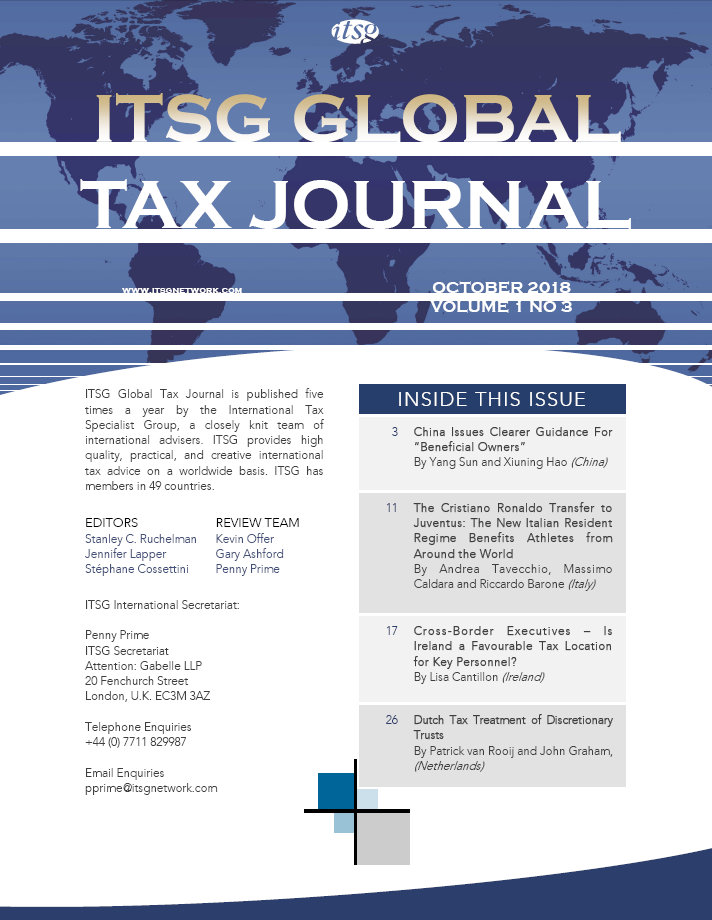INTRODUCTION
In Anglo-Saxon jurisdictions, the trust is often used to enable an ultimate transfer of assets to a spouse or children or for asset protection purposes. However, the tax treatment of the trust has long been a problem in countries that have neither a set of common law rules nor a specific trust law. In many countries, trusts are generally seen as abusive. This is particularly the case when a trust is a discretionary trust.
Fixed interest trusts are easier to deal with for income tax purposes and gift and estate tax purposes because a share of the trust assets can be allocated to each beneficiary. This is not the case for a discretionary trust – hence the problem.
Since the 1950’s, the practice of the Dutch tax authorities (the D.T.A.) was to tax the trust itself, as a separate entity, or any Dutch tax residents involved in the trust arrangement, whether settlors, beneficiaries or trustees. Results have varied.
Prior to 2010, Dutch tax literature and case law show that a grey area existed, resulting in the opportunity to exempt assets and income from taxation. In principle, this allowed an opportunity for tax planning, although it was difficult to obtain certainty. Some advisers took the view that, if a Dutch resident was the settlor of a discretionary trust in another jurisdiction, the amount settled could not be treated as a gift because no beneficiary was entitled to the transferred assets at the time of the gift. Then, at the time of a distribution to one of the discretionary beneficiaries, it was argued that the distribution could not be treated as a gift subject to Dutch gift tax because the party making the distribution was not a Dutch resident. Additionally, the income of the trust arguably was not taxed as earned because no beneficiary was entitled to receive the proceeds of the income.
This view regarding gift tax was overruled by case law dealing with transfers to a discretionary trust. The trust was considered to be an entity and the transfer was subject to Dutch gift or estate tax at the highest rate since the trust was not a relative, even if the settlor and the beneficiary were parent and child. However, no income tax would be imposed on the trust or its beneficiaries when and as earned when the trust was not managed from the Netherlands.
In 2010, legislation was introduced to address this problem. This resulted in the introduction of a new term, the “separate private fund” (in Dutch, the afgezonderd particulier vermogen or A.P.V.). An A.P.V. is a fund with a particular private objective, as opposed to a fund with a social or cultural objective, which broadly covers discretionary trusts, foundations or similar entities.
The new legislation treats assets that have been transferred to an A.P.V. as belonging to the individual who has transferred those assets, usually the settlor. Consequently, the settlor is taxed on those assets as if owned directly for both personal income tax purposes and gift and estate tax purposes. The Dutch system for unearned income, other than from a significant shareholding in a company, is based on a notional return. Consequently, the actual rate of tax depends on the income profile of the person to whom allocated.
In this paper, where we refer to income being allocated to a person, the actual position is normally that the assets are allocated to that person and the notional return is taxable in that person’s hands.
This means that a distribution from a trust to a beneficiary will be treated for Dutch tax purposes as a gift from the settlor to the beneficiary. If the settlor is an actual or deemed Dutch resident1, Dutch gift or estate tax exposure exists. Although Dutch gift and estate tax is levied on the recipient, tax exposure is dependent on the decedent or donor being resident or deemed resident in the Netherlands.
On the death of the settlor, the assets in the trust are generally attributed to the settlor’s heirs in accordance with their entitlement to the total estate under Dutch inheritance law. No consideration is given to the likelihood that an heir will receive anything from the trust or the fact that little or nothing is actually received from the trust.
In certain specific cases, if the trust operates a business which is taxed at a rate of 10%, the transparency rule does not apply for income tax purposes. In practice, there are relatively few trusts which will fall under this rule. As originally enacted, all assets with income taxed at 10% were not attributed to the settlor.
While this attribution can offer some planning opportunities, many pitfalls exist. Notwithstanding the intent or residence of the settlor at the time of transfer of assets, settlors and beneficiaries to a trust can unknowingly be subject to Dutch tax. This is especially the case with structures set up before the 2010 legislation came into effect. In all fact patterns, care is needed where a trust has a Dutch link, no matter how distant.
Some of the definitions used in the 2010 legislation are ambiguous and therefore leave room for interpretation, a discretion happily used by the D.T.A.
The balance of this article will look initially at several planning opportunities and then will address some of the issues that can arise.
PLANNING POSSIBILITIES
Frequently, the parents of a family will set up a trust for the benefit of the children and remoter descendants. In the past, this would not have led to difficulties in tax treatment because people tended to remain in the country where born. Now, with freedom of movement within the European Union, it is not unusual for children to become resident in another country for short or long periods.
It is relatively uncommon for a Dutch resident to set up a trust. Often it is the beneficiary who relocates to the Netherlands while the settlor lives in a common law country, often the United States, the United Kingdom or Australia. As long as the parents are alive and not resident in the Netherlands the children are not subject to Dutch tax on the income of the trust or on distributions received from the trust. This can enable wealth to be transferred without the transfer actually being taxable in the hands of the recipients, although tax exposure could arise once the assets have been transferred to the beneficiary.
In some instances, the residence country of the settlor may no longer treat the settlor as the owner of the assets. As a result, the income may not be taxed in either jurisdiction. On the other hand, the settlor can be taxed on the income upon a move to the Netherlands even though the settlor has no entitlement to the proceeds of trust income. Moreover, Dutch gift tax may be due on distributions from the trust to a beneficiary. Double tax may ensue.
If there is a desire to provide a benefit to a person who is not an heir and that person is a resident of the Netherlands, that beneficiary will not normally be subject to Dutch tax on income from the assets even after the death of the settlor.
Provided it remains an investment type of entity, the legislation also allows the use of a family foundation by Dutch residents. Prior to the 2010 legislation, contributions to and distributions from a foundation were potentially subject to Dutch gift tax. Because, foundations did not qualify for close relative tax rates, the transfer was taxed at the maximum rate. Today, that tax rate is 40%. The current rules allow the assets to be transferred to the foundation without any gift tax and a transfer from the foundation is deemed to be a transfer from the settlor to the beneficiary, which may qualify for the lower rates, which may be zero when the settlor is a nonresident settlor.
The use of a trust or foundation in this way may also offer some benefits for those planning to emigrate from the Netherlands. Dutch citizens are deemed to be resident in the Netherlands for gift and estate tax purposes for 10 years after the departure. In comparison, persons who are not Dutch citizens are deemed resident in the Netherlands for gift tax purposes for only one year after departure. A transfer of assets to a trust will not have any immediate tax effect in the Netherlands. At the same time, the country of arrival may take the view that no gift tax or income tax is due because the transfer to the trust occurred prior to arrival.
PRACTICAL PROBLEMS
While the mismatch between the actual beneficiaries and the parties considered beneficiaries can offer planning opportunities there are frequently situations where major problems arise. These are illustrated in the following fact patterns based on actual cases.
Who is the heir?
The legislation does not define the term "heir”. A US resident provided in her will that her estate should be divided among her children, Child A, Child B, and Child C. However, in the same will, she stated that the assets to be left to Child A should be placed in trust. The beneficiaries of that trust were Child A and Child A's descendants and if no descendants existed, the other two children and their descendants. The trustee was granted full discretion over the distribution of the assets to the beneficiaries. Child A was a resident of the Netherlands.
As discussed above, upon the death of the settlor the assets in the trust are allocated to the heirs in accordance with their entitlement to the estate. The questions here were whether Child A was an heir and, if so, the extent of her entitlement.
For one year, a compromise agreement was made with the D.T.A. that one-third of the assets in the trust were allocated to Child A. In the subsequent year, the tax authorities renounced that arrangement and asserted that all the assets in the trust were allocated to Child A. Moreover, the D.T.A. took the view that Child A was the settlor of the trust even though the trust was set up under the will of the mother. In the view of the D.T.A., the assets deemed to be inherited by Child A and, after a legal instant, Child A transferred the assets to the trust. On this basis, all the assets in the trust were attributed to Child A.
At some point, the D.T.A. realized that this approach would not stand up in court. Consequently, it adopted the position that all trust assets should be allocated to Child A since her siblings received their “fair share” of the estate and were not likely to receive anything from the trust given their third position as a claimant to assets. The D.T.A. did not consider the ages of the children of Child A. Moreover, no provision in Dutch law supported the approach of the D.T.A. Indeed, the parliamentary papers and the actual legislation clearly provide that a person can be considered a beneficiary unless there is absolutely no chance of the person receiving any asset under the terms of the legal document and the facts involved.
Two further challenges existed with regard to the position of the D.T.A. The first challenge was that Child A was not an heir at all since her “share” in the estate was placed in trust and she was not entitled to any distribution from the estate. The second challenge was that even if she were to be considered an heir, her share of the estate was zero. Consequently, nothing should be allocated to her.
In the case, the court of first instance decided to allocate one third of the assets in the trust to Child A. While this is a compromise which may have the benefit of “feeling right” to the judge, from a technical point of view we consider this an incorrect decision, since Child A received no assets from the estate. Therefore, even if Child A was an heir, her share in the estate was zero so that the proportion of the trust income which should be allocated to her is also zero.
This case is currently subject to appeal by both parties. Annotators on the case take the view that the inspector will not win.
Problems with Dutch-resident relatives
A Dutch citizen emigrated to South Africa and lived there for many years. He died without children. During his life, he set up a trust for the benefit of his relatives and such other individuals as the trustees might determine. Shortly before his death, he left a letter of wishes providing that after his death the trust should make some distributions to certain friends and to certain relatives. The friends were mostly resident outside the Netherlands. However, the relatives were Dutch residents.
At his death, the individual was a resident of South Africa. The question arose as to the Dutch tax consequences of the trust. The trustees agreed to follow the letter of wishes in exercising discretion provided in the trust deed. Thus, it was argued that the trust was no longer a discretionary trust because the letter of wishes amounted to written directions as if part of the trust instrument.
The D.T.A. was not prepared to accept this view. According to the D.T.A., the assets in the trust should be treated as if they were first deemed to be allocated to the relatives who were heirs of the decedent and then the heirs were deemed to make gifts to the actual beneficiaries. For Dutch tax purposes, the gifts were made proportionally by each relative. Because the relatives were all Dutch residents, the deemed gifts were subject to Dutch gift tax, even though, if the deceased had left the assets directly to his friends under his will there would have been no Dutch tax. This resulted in a tax liability of several hundred thousand euros, simply because a trust was interposed.
In comparison to the first case, where the D.T.A. took the view that the tax treatment under the law provided for an unreasonable notional allocation that should not be followed, in this case, the D.T.A. refused to deviate from their interpretation of the law, even though it appeared to be unreasonable. The letter of wishes was ignored as a meaningful document.
A difficult relationship with stepmother
An individual and his sister were residents of the Netherlands. The father was not a resident of the Netherlands and had remarried. Prior to his death, a discretionary trust was set up for the benefit of his wife and children in which his wife was co-trustee with a third party. On the father’s death in 2004, he left all of his assets other than certain bequests to the trust. The trust deed provided that on father’s death certain relatively small fixed amounts would be paid to the children, a certain fixed amount would be retained in the trust for the benefit of the stepmother and the children, and the balance would be paid out to the stepmother. The trust deed directed the trustee to ensure that the stepmother was to be provided for in the manner to which she was accustomed at the time of the settlor’s death.
Before the introduction of the A.P.V. legislation, it was agreed with the tax authorities that the Dutch resident children did not need to report anything in respect of the trust since it was considered unlikely that they would receive income, and if they were to receive anything from the trust, it would most likely be non-taxable capital rather than income.
After the introduction of the A.P.V. legislation, the D.T.A. adopted the view that the stepmother and children should be considered as heirs and one-third of the assets of the trust should be allocated to each. This approach appears to be inappropriate. Under general case law applicable to foundations, the foundation should be ignored because the stepmother was both one of the trustees and the primary beneficiary and she, therefore, had full control over the assets. All the assets should be considered to be owned by her. Alternatively, if the trust cannot be considered the heir, it should be considered to be “transparent” in identifying the heirs and the proportion of the estate each received. Since most of the assets went to the stepmother, most if not all of the assets in the trust should be attributed to her for Dutch tax purposes.
One of the issues here is that no individual person is shown as heir in the will. If the trust is to be treated as an heir, the D.T.A. position is contrary to the object of the legislation. Moreover, if the stepmother and children should be treated as heirs, how does one allocate the proportions? The children had no knowledge as to the amount the stepmother actually received, and the stepmother is uncooperative.
This case is still in its early stages but illustrates some of the challenges which can arise from what may be considered a normal provision in another country.
CONCLUSION
At first sight, Dutch legislation covering the tax treatment of discretionary trusts looks quite straightforward. However, many practical problems exist. This is partly due to the fact that income can be allocated to people other than the actual beneficiaries so that taxes can be payable in unexpected circumstances and partly because the legislation does not take account of situations which may be normal in other countries.
1 Under Dutch inheritance and gift tax concepts, receipts from actual or deemed Dutch tax residents are subject to inheritance or gift tax. Receipts from nonresidents are not subject to either Dutch tax.

 Login
Login




















































